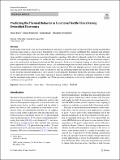Predicting the Thermal Behavior in Functional Textile Fibers Having Embedded Electronics
Author(s)
Berry, Shaun; Redmond, Shawn; Wang, Tairan; Rothschild, Mordechai
Downloads42765-022-00195-y.pdf (2.794Mb)
Publisher with Creative Commons License
Publisher with Creative Commons License
Creative Commons Attribution
Terms of use
Metadata
Show full item recordAbstract
<jats:title>Abstract</jats:title><jats:p>In this paper, both steady-state and transient thermal simulations were performed on functional fibers having an embedded electronic chip acting as a heat source. Simulations were conducted for a range of different fiber materials and arbitrary fiber cross-sectional shapes. We show that under steady-state heating conditions, the thermal response for any arbitrary fiber shape and fiber material system was convection dominated regardless of the effective thermal conductivity of the fiber, and that the corresponding temperature rise within the fiber can be predicted analytically allowing for the maximum temperature to be estimated for any known heat load and fiber geometry. In the case of transient heating, we show that for pulsed power operation of the embedded electronic device, the maximum temperature reached in the fiber is always greater than the maximum temperature of the equivalent steady-state average power. However, high peak powers can be safely achieved if the power-on pulse time and duty cycle are selected to limit the maximum temperature reached in the fiber. Based on the results from the transient simulations, a set of criteria was developed to determine whether the operating conditions would be: (1) allowable for the fiber system, thus requiring no transient simulations, (2) requiring a transient simulation to verify that the maximum temperature is acceptable, and (3) the operating conditions are too severe and device operation at these conditions are not practical.</jats:p>
<jats:p><jats:bold>Graphical Abstract</jats:bold></jats:p>
Date issued
2022-09-08Department
Lincoln LaboratoryPublisher
Springer Science and Business Media LLC
Citation
Berry, Shaun, Redmond, Shawn, Wang, Tairan and Rothschild, Mordechai. 2022. "Predicting the Thermal Behavior in Functional Textile Fibers Having Embedded Electronics."
Version: Final published version
ISSN
2524-7921
2524-793X
Keywords
General Materials Science